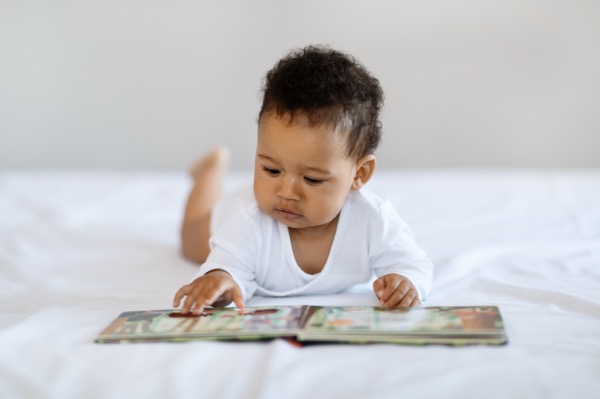This is such an exciting age, filled with curiosity and discovery, as they start to recognize familiar faces and sounds. You’ll be captivated by their wonder as they look at colorful books and listen to the sound of your voice. You can nurture these skills by knowing what is the best way to read to your baby.
Building Connections
At 7 to 8 months babies are starting to develop object permanence and memory skills, which means they might even look for toys or objects you’ve just hidden.
- As you turn the pages of a story, your baby will begin to associate the words and images with real-life objects. To make this reading experience even more engaging, try grabbing toys that match the pictures in the book. For example, if you’re reading about animals, hold up a small stuffed bunny when the book mentions a rabbit, and then show a toy frog when the frog comes up.
- Look for board books with flaps or textures, too! As you lift the flaps, encourage your little one to search for hidden characters. This makes reading fun but also prompts them to recall what they just saw.
- Don’t forget to pause during your reading and ask simple questions like, “Where’s the cat?” or “Can you find the teddy bear?” These questions encourage your baby to think and look for answers, boosting their observational skills.
Rhythm and Babble
Reading it’s also a great time to boost their babbling skills! At this age, they love to mimic sounds, engage in playful babbling, and respond to your voice with their own. When you read aloud, you’re creating a rich environment filled with new sounds and words, which encourages them to experiment with their own voice. You are giving them a chance to hear the rhythm and melody of language, which is key to developing their babbling. Plus, the more you interact, the more they learn about the back-and-forth flow of conversation.
Look for books with a rhythmic or repetitive quality. These repetitive phrases make it easy for your baby to join in, allowing them to mimic sounds and words more effectively. Don’t be afraid to get a little theatrical while you read! Use different tones and pitches for characters to make the story come alive. To learn how to effectively use high and low sounds, and enhance your baby’s auditory skills by playing with different voice pitches, watch this video.
As you read a sentence or finish a page, take a moment to pause and give your baby a chance to respond. If your baby starts to babble, respond as if you’re having a real conversation. Repeat their sounds and add new ones. Whether they babble, coo, or make funny faces, this turn-taking reinforces the idea of conversation and encourages them to express themselves.
Hands-On Reading
Start by picking books with familiar themes that relate to their daily life—like bath time, feeding, or bedtime. As you read, you can relate the story to their own experiences, helping them make connections and understand the world a little better.
To make things even more interesting, try positioning the book just out of their line of sight. This encourages them to twist their bodies to see it, which can help prepare them for rolling over from tummy to back!
As you read, encourage your baby to reach out and explore the pages. Say things like, “Look, this puppy is so soft! Can you touch it?” This keeps them engaged and also gives them a reason to crawl closer.
Choosing sturdy board books with thick pages is a great idea, too. They’re perfect for little hands eager to grab and turn pages. Encourage your baby to hold the book and help turn the pages as you read together. You might say, “Let’s see what happens on the next page! Can you grab it?”
Using a basket or container to store their books can add to the fun. Encourage your baby to reach in and pull out a book, which boosts their grasping skills and gives them a sense of ownership over storytime. Try saying, “What’s inside? Let’s find out!” You can also boost your baby’s fine motor skills while reading by using cereal to turn pages; to see how this fun activity can help develop their dexterity, watch this video here!
Book Recommendations
Here’s a selection of books for this stage that can help you boost this reading journey:
- “Dear Zoo” by Rod Campbell, introduces various animals and encourages interaction, helping babies develop their fine motor skills.
- “The Very Hungry Caterpillar” by Eric Carle, a classic book with illustrations where babies can “find” the caterpillar hidden among various foods.
- “All the World” by Liz Garton Scanlon, a book that captures everyday moments and family routines, helping babies recognize the world around them through rhythmic language.
Happy reading!








